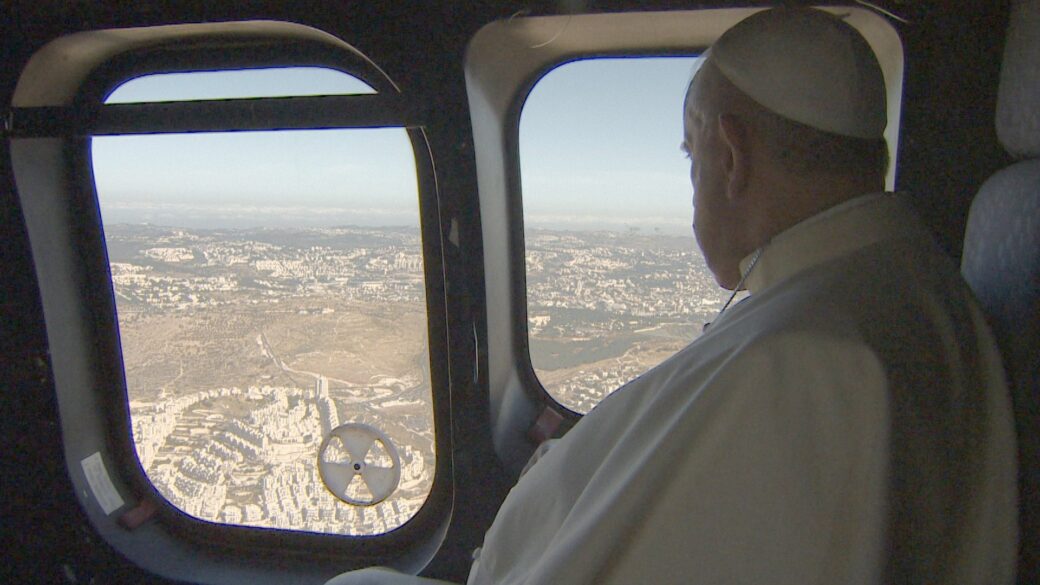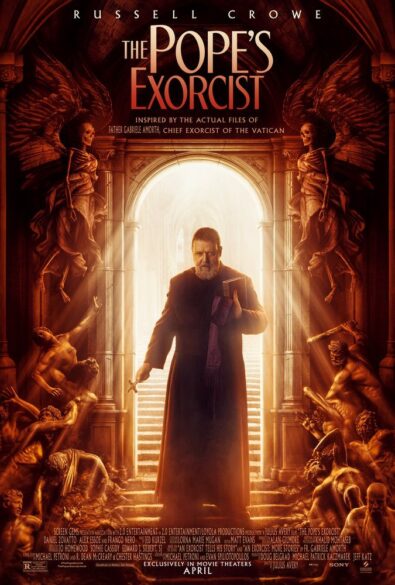In Viaggio: The Travels of Pope Francis
By John Mulderig
NEW YORK (OSV News) – “Do not be afraid to dream.” That’s one of the characteristic statements viewers encounter in the uplifting documentary “In Viaggio: The Travels of Pope Francis” (Magnolia).
Despite its depiction of some of the world’s most pressing problems, filmmaker Gianfranco Rosi’s polished retrospective maintains a tranquil tone as it looks back over the 37 journeys to 53 different countries undertaken by the pontiff during the first nine years of his pontificate. The result is thoughtful fare suitable for grown-ups and teens.

As Francis globe-trots from the halls of Congress to the Philippines and on to the streets of Havana, he speaks his mind about refugees, migrants, poverty, war and the need to imagine a better future. He also grapples with the scandalous abuse crisis in the church and the all-too-understandable sensitivities it has created, especially among victims.
Rosi adopts a hands-off, cinema verite approach to his work, eschewing vocal narration and incorporating stretches of contemplative silence. Always meditative, his profile also is sometimes moving, as when it captures Francis’ one-on-one exchanges with the inmates of a Mexican prison.
A sequence showing the pope walking through a deserted St. Peter’s Square at the height of the COVID pandemic is a striking reminder of the isolation to which that disease reduced so many around the world. In a voiceover, Francis ponders the possibility that the tragedy was the outcome of modern people’s unwillingness to slow themselves down and listen to God’s voice.
Along with the discussion of topics that make it inappropriate for youngsters, Rosi’s picture also includes footage that might upset them. Thus we’re shown real-life scenes of shipwreck, violent conflict and death.
While not pulling his punches, however, Rosi successfully captures the peaceable atmosphere that generally surrounds Pope Francis. Accordingly, his portrait of a pontiff on the move – energetically yet calmly bringing his message of hope to a rich variety of destinations – can be thought of as an appealing 80-minute opportunity for spiritual reflection.
The film contains mature themes, including the sexual abuse of children, potentially disturbing images and situations of peril. The OSV News classification is A-II – adults and adolescents. Not rated by the Motion Picture Association.
The Pope’s Exorcist
By John Mulderig
NEW YORK (OSV News) – It’s important to bear in mind that, however credible its source material may be, the ostensibly fact-based possession tale “The Pope’s Exorcist” (Sony) remains a Hollywood horror movie. Considered as such, the film starts off promisingly enough but eventually becomes overheated and lurid.
Any adaptation of books published by high-profile exorcist Pauline Father Gabriele Amorth, who died in 2016, aged 91, is unlikely to be fare suitable for the whole family, moreover. And so it proves in this case since, as directed by Julius Avery, the picture includes a variety of components that even grown-ups in search of casual entertainment may wish to avoid.

Star Russell Crowe brings verve to his portrayal of Father Amorth. Genial and fond of a joke, the cleric is nonetheless never frivolous. Perhaps the most characteristic image among the opening scenes is that of Father Amorth riding his Vespa scooter through the streets of Rome backed by Faith No More’s refrain, “It’s a dirty job but someone’s gotta do it.”
From the Eternal City we jump to Spain, where a trio of Americans – widowed mom Julia (Alex Essoe), rebellious teen daughter Amy (Laurel Marsden) and traumatized preteen son Henry (Peter DeSouza-Feighoney) – are living temporarily. They’ve taken up residence in a former abbey while Julia supervises its renovation with an eye to selling it.
Of course, the spooky old place turns out to be haunted by a demon (voice of Ralph Ineson) who promptly puts Henry under his dominion. Local priest Father Esquibel (Daniel Zovatto) tries to help but he’s way out of his depth. Time to summon Father Amorth.
In fact, it develops that Father Amorth’s presence is part of a scheme the unholy spirit has concocted for infiltrating the Vatican. There, an entirely fictional pope (Franco Nero) is not only ailing but surrounded by fractious prelates – some allies of Father Amorth, others his opponents.
While the focus remains on young Henry’s plight, the movie feels dramatically compact and sound, though not lacking in genre cliches. And screenwriters Michael Petroni and Evan Spiliotopoulos successfully make the case for taking the power of evil seriously.
As the duo of clergymen research the abbey’s past, however, extraneous elements ranging from contemporary divisions within the church to the legacy of the Spanish Inquisition are thrown into the mix – and depicted ineptly. As a result, the proceedings eventually degenerate into a muddle while the tone becomes increasingly sensationalist.
Details of religious practice are also portrayed inaccurately. Thus in two of the three confessions we witness on screen, the confessor fails to use the necessary formula of absolution, substituting instead a vague prayer that the penitent may be forgiven. Any well catechized Catholic would demand a do-over.
Speaking of ecclesiastical tensions, in the midst of it all Father Amorth makes an observation that might be taken for heresy in some circles these days. “Prayers,” he tells Father Esquibel, “are more powerful in Latin.”
The film contains mature themes, disturbing images, an attempted suicide, brief aberrant sexual interaction, glimpses of upper and rear female nudity, a few mild oaths, numerous rough terms, occasional crude language and an obscene gesture. The OSV News classification is L – limited adult audience, films whose problematic content many adults would find troubling. The Motion Picture Association rating is R – restricted. Under 17 requires accompanying parent or adult guardian.
